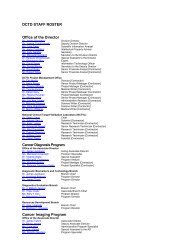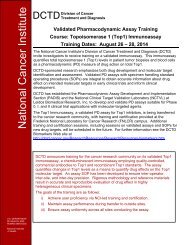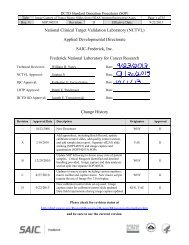National Cancer Institute - NCI Division of Cancer Treatment and ...
National Cancer Institute - NCI Division of Cancer Treatment and ...
National Cancer Institute - NCI Division of Cancer Treatment and ...
You also want an ePaper? Increase the reach of your titles
YUMPU automatically turns print PDFs into web optimized ePapers that Google loves.
DTP oversees animal-production facilities that produce<br />
inbred <strong>and</strong> hybrid strains <strong>of</strong> rats, mice, <strong>and</strong> guinea pigs.<br />
This program provides researchers nationwide with<br />
genetically defined, pathogen-free laboratory animals.<br />
Animal Production<br />
http://dtp.nci.nih.gov/branches/btb/<br />
services.html#AnimalProduction<br />
DTP’s Biological Testing Branch oversees<br />
animal-production facilities that produce<br />
inbred <strong>and</strong> hybrid strains <strong>of</strong> rats, mice,<br />
<strong>and</strong> guinea pigs. This program provides<br />
researchers nationwide with genetically<br />
defined, pathogen-free laboratory animals<br />
as well as animal-related services such<br />
as jugular vein cannulations, vasectomies,<br />
ovariectomies, <strong>and</strong> castrations. In 2005,<br />
the branch distributed 1,473,062 rodents<br />
to about 1700 investigators at 240<br />
institutions.<br />
In Vitro Screening: The Human<br />
Tumor Cell Line Assay<br />
http://dtp.nci.nih.gov/branches/btb/<br />
ivclsp.html<br />
In 1985, the hypothesis was put forward<br />
that a human tumor cell line screen<br />
could help investigators discover celltype–specific<br />
agents with clinical activity<br />
against solid tumors. The emerging reality<br />
was that while correlation <strong>of</strong> in vitro histology<br />
to clinical activity is poor, the pattern<br />
<strong>of</strong> cellular sensitivity <strong>and</strong> resistance <strong>of</strong><br />
the cell lines to the drug correlated with<br />
molecular target expression.<br />
In response, DTP developed a cell-line–<br />
based screen representing the major<br />
classes <strong>of</strong> solid tumors. That allowed<br />
relatively inexpensive <strong>and</strong> rapid testing<br />
<strong>of</strong> potential therapeutic agents against<br />
broad panels <strong>of</strong> human tumors that<br />
could be adapted to the needs <strong>of</strong> natural<br />
product screening.<br />
106 ■ P R O G R A M A C C O M P L I S H M E N T S 2 0 0 6<br />
■ ■ ■<br />
Since April 1990, DTP has used the human<br />
tumor cell line in vitro screen as its primary<br />
assay with follow-up in vivo evaluation in<br />
the hollow fiber assay. The screen is currently<br />
composed <strong>of</strong> 59 human tumor cell<br />
lines, representing leukemia, melanoma,<br />
<strong>and</strong> cancers <strong>of</strong> the lung, colon, brain, ovary,<br />
breast, prostate, <strong>and</strong> kidney. These cell<br />
lines were selected partly on pragmatic<br />
terms: those selected behaved best under<br />
typical assay conditions. The screen was<br />
designed so that for each compound<br />
tested, both the absolute <strong>and</strong> the relative<br />
sensitivities <strong>of</strong> individual cell lines were<br />
reproducible to the extent that a characteristic<br />
pr<strong>of</strong>ile or fingerprint <strong>of</strong> cellular<br />
response was generated.<br />
Although the particular inhibitory<br />
response <strong>of</strong> a single cell line might be<br />
relatively uninformative, the pattern <strong>of</strong><br />
response <strong>of</strong> the cell lines as a group can<br />
be used to rank a compound according<br />
to the likelihood <strong>of</strong> sharing common<br />
mechanisms. The COMPARE algorithm<br />
(a computer program) qualifies this<br />
pattern <strong>and</strong> searches an inventory <strong>of</strong><br />
screened agents to compile a list <strong>of</strong> the<br />
compounds that have the most similar<br />
patterns <strong>of</strong> cellular sensitivity <strong>and</strong><br />
resistance.<br />
Extramural researchers who wish to<br />
access this service should complete an<br />
online submission form: http://dtp.nci.<br />
nih.gov/compsub/index.html. Pure compounds<br />
must be <strong>of</strong> known molecular<br />
structure, <strong>and</strong> the investigator is required<br />
to enter the molecular structure on the<br />
online submission form before sending<br />
samples <strong>of</strong> the test compound. Additional










